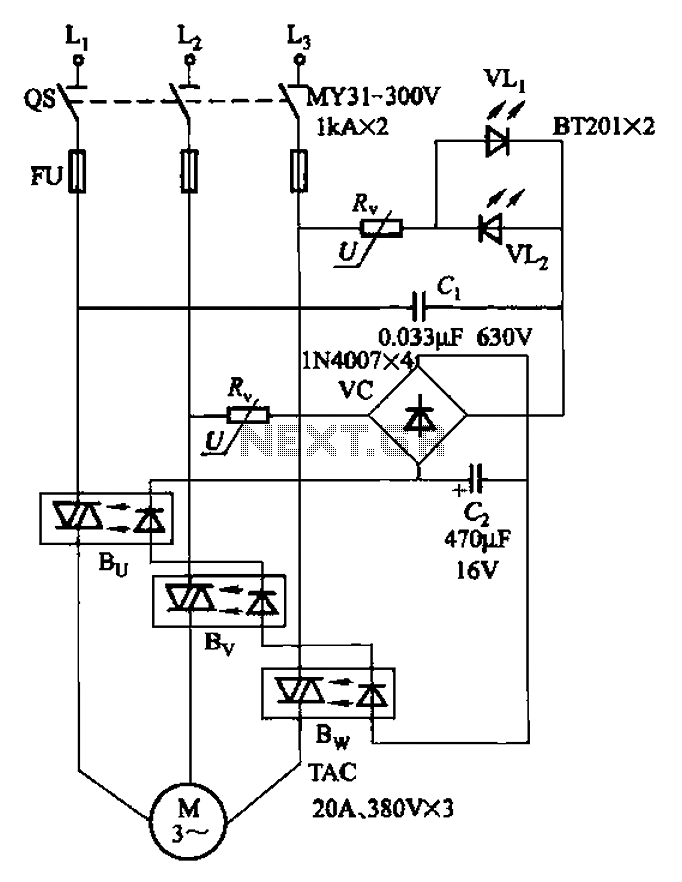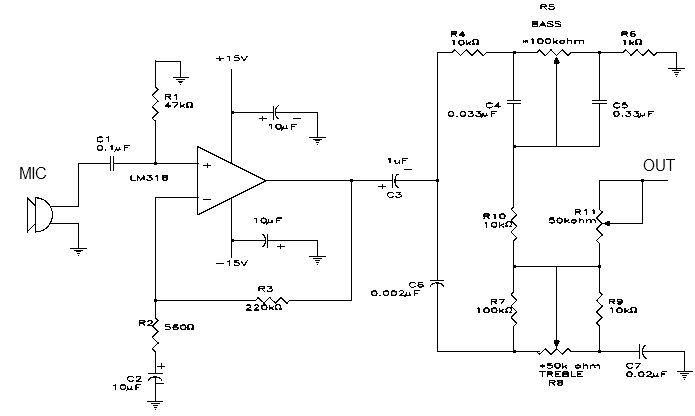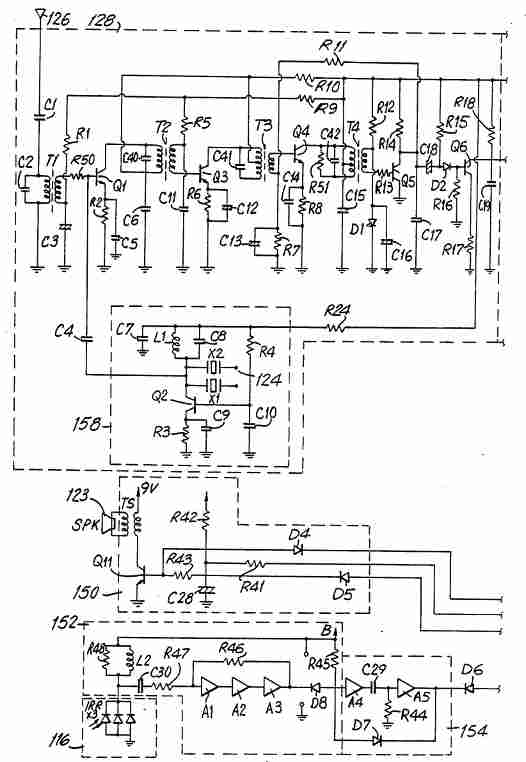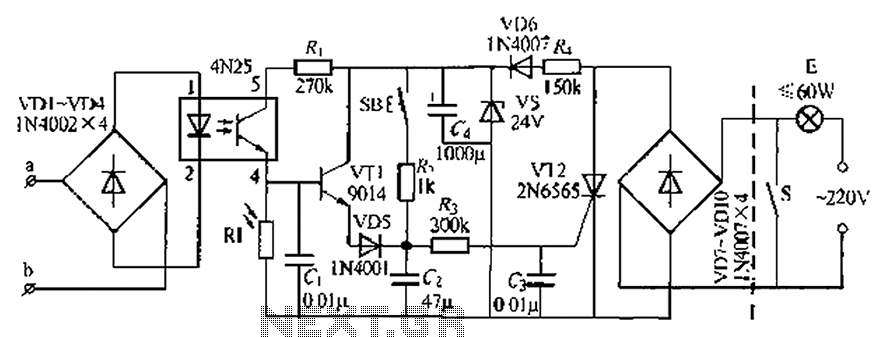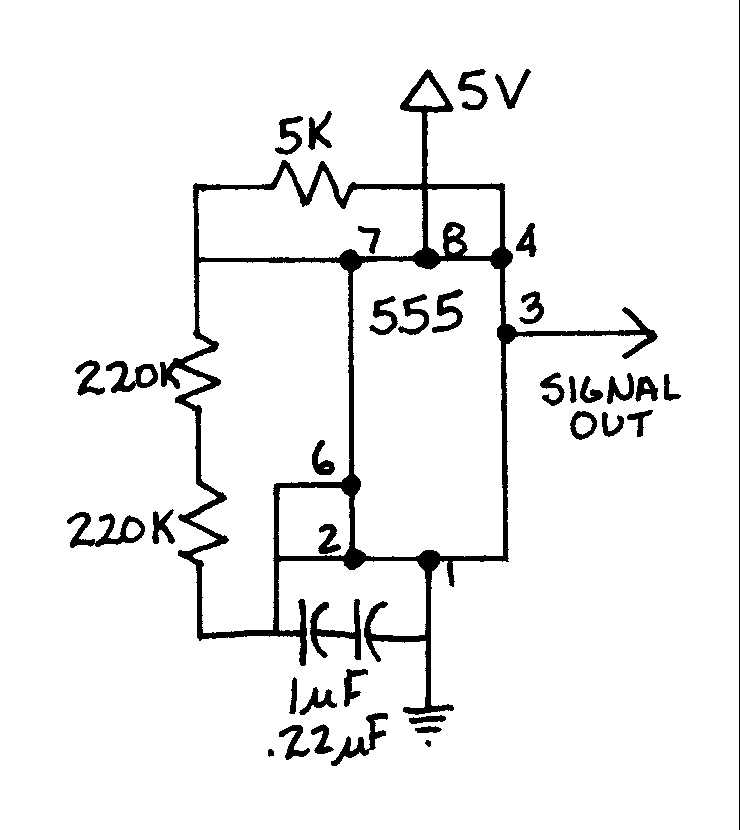
Infrared Remote Control Tester
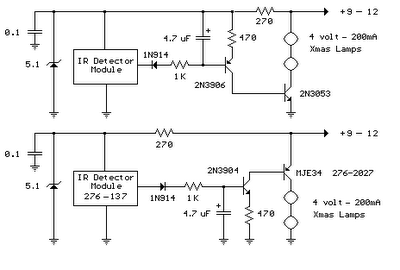
The infrared detector module (GP1U52X) (Radio Shack 276-137) generates a 5-volt TTL pulse train that corresponds to the digital code from a remote control button. In the circuit diagram, the module's output is normally low, producing a positive pulse train when a signal is detected. Other detector modules with an inverted output are represented in the upper drawing, although the specific part number is unknown; it is suspected to originate from a video recorder. The pulse sequence for the digital codes of special keys can be obtained directly from the manufacturer. When the pulse train is active, a 4.7 µF capacitor charges to approximately 3 volts, and the voltage across the capacitor minus the diode drop appears across a 470-ohm resistor, resulting in a collector current of about 5 milliamperes flowing through a 2N3904 or 2N3906 transistor. This collector current from the first stage feeds into the base of an output transistor (2N3053 or MJE34), which can provide around 250 mA in the output direction. When the pulse train ceases, the capacitor discharges slowly through the first transistor stage, allowing the Christmas tree lights to illuminate for about one second. The small Christmas lights can operate over a wide voltage range, making it possible to use bulbs from nearly any string, although shorter strings (35 bulbs or fewer) will likely run longer at a minimum of 5 volts. The circuit can be powered by a small 9-12 volt DC wall transformer rated at 250 mA or higher. An additional 1000 µF capacitor can be added to filter the DC output if the wall transformer lacks a built-in capacitor. For operation with a 9-volt battery, the light bulbs can be replaced with a simple LED and a 680-ohm resistor, and the output transistors can be substituted with low-signal transistors (2N3904 or 2N3906). The total current draw is approximately 25 mA with the LED lights in standby mode and 15 mA when the LED is active.
The infrared detector module GP1U52X is designed to interface seamlessly with various remote control systems, allowing for the detection and processing of infrared signals. The module outputs a TTL-compatible pulse train, which is essential for digital signal processing in applications such as remote control receivers. The circuit is structured to ensure that the output remains low until an infrared signal is detected, at which point the pulse train is generated, indicating activity.
The 4.7 µF capacitor plays a crucial role in the timing aspect of the circuit, charging quickly upon receiving a pulse and discharging gradually to maintain the output state. This behavior is particularly useful in applications where a brief illumination of lights is desired, such as in decorative lighting setups. The choice of transistors (2N3904 or 2N3906) for the initial amplification stage ensures that the circuit can handle the necessary current levels to drive larger output transistors (2N3053 or MJE34), which are capable of supplying sufficient current for lighting applications.
The circuit's flexibility is highlighted by its ability to operate over a range of input voltages, accommodating various power sources, including wall transformers and batteries. The inclusion of a filtering capacitor enhances stability, particularly in scenarios where the power supply may not provide a clean output. The option to replace the light bulbs with LEDs further extends the circuit's versatility, allowing for energy-efficient operation while still providing adequate illumination.
Overall, this infrared detector circuit exemplifies a robust design that can be adapted for various applications, from simple remote control functions to more complex lighting solutions. Its ability to operate with different components and power sources makes it a valuable addition to any electronics project involving infrared signal detection and processing.The infrared detector module (GP1U52X) (Radio Shack 276-137) provides a 5 volt TTL pulse train corresponding to the digital code to the button of the remote control. In the lower circuit, the module output normally low a signal and a positive going pulse train whena signal is present.
Other detector modules that an inverted output is in the upper drawing, which showed type I, but I do not have the part number, I think from a video recorder. The pulse sequence, the digital codes of special keys is available with information directly from the manufacturer. Since the pulse train occurs, the 4. 7uF capacitor charges to approximately 3 volts and the capacitor voltage minus a diode drop appears above the 470-ohm resistor, a collector current of the 2N3904 or 2N3906 about 5 milliamperes.
The collector current of the first stage flows into the base of the output transistor (2N3053 or MJE34), which provides about 250 mA in direction. If the pulse train ends of the capacitor discharged slowly through the bottom of the first transistor stage left, the Christmas tree lights for about 1 second.
The little Christmas lights will operate over a wide voltage range, so you can use bulbs from almost any string, but spheres of short strings (35 or less) will probably run longer at least 5 volts. The circuit can be a small 9-12 volt DC, 250 mA wall transformer or operated higher. It can also be an additional 1000 uF capacitor filter on the DC output if the wall transformer no built-in capacitor.
For use with a 9 volt battery, the light bulbs are replaced by a simple LED and 680 Ohm resistor and the output transistors by low signal transistor (2N3904 or 2N3906) can be replaced. The total power is about 25 mA with LED lights, standby and 15 mA when the LED should be. 🔗 External reference
The infrared detector module GP1U52X is designed to interface seamlessly with various remote control systems, allowing for the detection and processing of infrared signals. The module outputs a TTL-compatible pulse train, which is essential for digital signal processing in applications such as remote control receivers. The circuit is structured to ensure that the output remains low until an infrared signal is detected, at which point the pulse train is generated, indicating activity.
The 4.7 µF capacitor plays a crucial role in the timing aspect of the circuit, charging quickly upon receiving a pulse and discharging gradually to maintain the output state. This behavior is particularly useful in applications where a brief illumination of lights is desired, such as in decorative lighting setups. The choice of transistors (2N3904 or 2N3906) for the initial amplification stage ensures that the circuit can handle the necessary current levels to drive larger output transistors (2N3053 or MJE34), which are capable of supplying sufficient current for lighting applications.
The circuit's flexibility is highlighted by its ability to operate over a range of input voltages, accommodating various power sources, including wall transformers and batteries. The inclusion of a filtering capacitor enhances stability, particularly in scenarios where the power supply may not provide a clean output. The option to replace the light bulbs with LEDs further extends the circuit's versatility, allowing for energy-efficient operation while still providing adequate illumination.
Overall, this infrared detector circuit exemplifies a robust design that can be adapted for various applications, from simple remote control functions to more complex lighting solutions. Its ability to operate with different components and power sources makes it a valuable addition to any electronics project involving infrared signal detection and processing.The infrared detector module (GP1U52X) (Radio Shack 276-137) provides a 5 volt TTL pulse train corresponding to the digital code to the button of the remote control. In the lower circuit, the module output normally low a signal and a positive going pulse train whena signal is present.
Other detector modules that an inverted output is in the upper drawing, which showed type I, but I do not have the part number, I think from a video recorder. The pulse sequence, the digital codes of special keys is available with information directly from the manufacturer. Since the pulse train occurs, the 4. 7uF capacitor charges to approximately 3 volts and the capacitor voltage minus a diode drop appears above the 470-ohm resistor, a collector current of the 2N3904 or 2N3906 about 5 milliamperes.
The collector current of the first stage flows into the base of the output transistor (2N3053 or MJE34), which provides about 250 mA in direction. If the pulse train ends of the capacitor discharged slowly through the bottom of the first transistor stage left, the Christmas tree lights for about 1 second.
The little Christmas lights will operate over a wide voltage range, so you can use bulbs from almost any string, but spheres of short strings (35 or less) will probably run longer at least 5 volts. The circuit can be a small 9-12 volt DC, 250 mA wall transformer or operated higher. It can also be an additional 1000 uF capacitor filter on the DC output if the wall transformer no built-in capacitor.
For use with a 9 volt battery, the light bulbs are replaced by a simple LED and 680 Ohm resistor and the output transistors by low signal transistor (2N3904 or 2N3906) can be replaced. The total power is about 25 mA with LED lights, standby and 15 mA when the LED should be. 🔗 External reference
